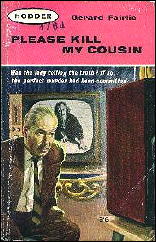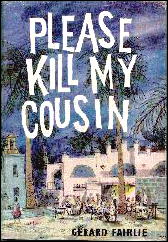Sun 1 Apr 2012
Reviewed by Geoff Bradley: GERARD FAIRLIE – Please Kill My Cousin.
Posted by Steve under Reviews[3] Comments
GERARD FAIRLIE – Please Kill My Cousin. Hodder, UK, paperback, 1963. Original edition: Hodder & Stoughton, hardcover, 1961. No US edition.

I’m a sucker for a gimmick. I was browsing a rack of cheap paperbacks outside a secondhand bookshop and saw this. I had read several of Fairlie’s Bulldog Drummond books when I was a boy, following on from Sapper (H. C. McNeile)’s series, and at least one I think of his other books. (Indeed, I have read that McNeile actually based his character on Fairlie.)
This is the sixth and final book in his series about private detective Johnny Macall, and I suspect it was one of the earlier ones in this series that I read. (I can’t remember anything about it of course, but these days it’s hard to remember what I read last week.)
The gimmick is obvious on the contents page which I turned to after I had idly picked the book up. The first part (some 146 pages), Macall narrates as he is hired by a lady to find her long-time friend who has disappeared. He finds that after receiving a large inheritance from her aunt she had set up home with a housekeeper, butler and a chef and maid but that all four have disappeared at the same time that she has travelled to Las Palmas.
Macall interviews a disgruntled cousin, who didn’t inherit, and travels, with his wife Moira, to the Canaries but is unable to find sufficient evidence to prove what has happened.
Now we come to the second part, four pages of correspondence between Macall and his friend Gerard Fairlie (!) in which Macall sends his report (i.e., the first part of the book) to “Gerry” and asks him to use his imagination and come up with a fictional account of what might have happened.

The third part, some 60 pages, is a television script written in response by “Gerard Fairlie” in which he outlines a possible scenario as a television script. The script ends with an announcer asking the audience if this is a “Perfect Murder” and inviting them to send in their solutions as to how the crime could be uncovered.
There will be another programme in a month’s time and a reward of £1000 (quite a sum) will be awarded to the best entry.
In a two page letter to Macall, that makes up the fourth part of the book, “Fairlie” says that Macall’s story has given him an idea for a series on “perfect murders” and that the competition may produce some good ideas and the prize money may even tempt one of the conspirators to enter.
In the fifth and final section, some 36 pages, Macall hatches a plan with his Scotland Yard buddy, Detective Superintendent Francis, that uncovers the crime and brings the criminals to justice.
I wouldn’t recommend this as an outstanding book but I have to say I did quite enjoy it and the gimmick was enjoyably, if a little implausibly, done. There must be other instances of an author inserting himself into a story (other than the Kinky Friedman kind of thing) but inserting himself as a writer helping out his own character is a little unusual.
Editorial Comment: This was the final book in Gerard Fairlie’s mystery-writing career, which began in 1927. If the gimmick in this book sounds as interesting to you as it does to me, let me warn you that right now only a small handful of copies are being offered for sale on the Internet, and most of them are located in New Zealand or Australia. The good news is that one of them, a hardcover edition, will set you back only something like $20, including postage, unless I decide to go for it first.
April 2nd, 2012 at 6:59 am
Over the years I saw this in various outlets around Britain as I know I had a couple of copies. Maybe I should have read it before getting rid of it…
April 2nd, 2012 at 9:19 am
I’ve just checked bookfinder.com. It is hard to tell, since sellers offer their wares on multiple sales venues, but there appears to be only 4 or 5 hardcover copies up for sale, and no paperbacks at all.
One copy is in South Africa, leaving only one in the hands of a British bookseller. The others, as I mentioned before, are in New Zealand and Australia. This is surprising. You’d think the paperback would show up more than the hardcover, and more would be in the UK than anywhere else. In both cases, not so.
April 2nd, 2012 at 4:18 pm
I think I’ve got two copies of the hardback in stock (I’ll have to check). I did also have an author inscribed copy a few years ago but sold it. I don’t recall having had the paperback however